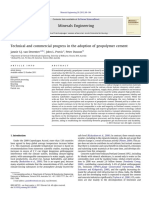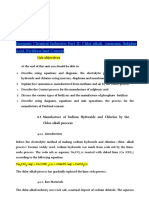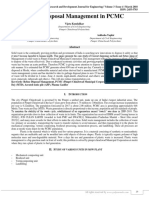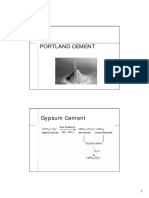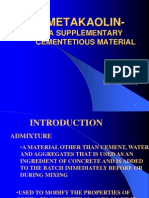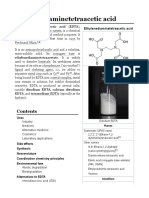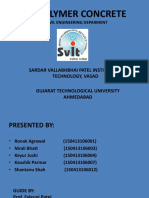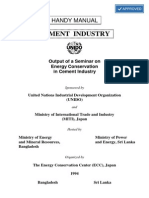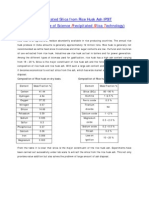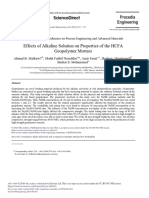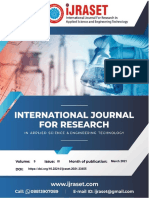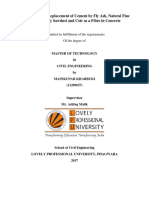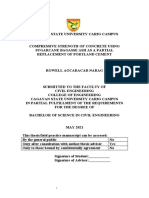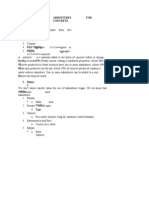Professional Documents
Culture Documents
Durability of Fly Ash Based Geopolymer Concrete Against Chloride and Sulphuric Acid Attack
Copyright
Available Formats
Share this document
Did you find this document useful?
Is this content inappropriate?
Report this DocumentCopyright:
Available Formats
Durability of Fly Ash Based Geopolymer Concrete Against Chloride and Sulphuric Acid Attack
Copyright:
Available Formats
Volume 5, Issue 6, June – 2020 International Journal of Innovative Science and Research Technology
ISSN No:-2456-2165
Durability of Fly Ash Based Geopolymer Concrete
against Chloride and Sulphuric Acid Attack
1 2
Kartika Ilma Pratiwi, currently pursuing Master Degree Saloma, lecturer in Civil Engineering
Program in Civil Engineering, Sriwijaya University, Department in Sriwijaya University, Indonesia,
Indonesia
Abstract:- The aim of this study was to replace Portland media were tested by comparing the effects of conventional
cement with fly ash-based geopolymer as precursors, to concrete. Singh et al. [5] reported on the excellent acid
serve as a binder after reacting with NaOH and Na2SiO3 resistant ability of fly ash-based geopolymer concrete (GPC)
activators. The test object existed in the form of a cube against sulfuric and chloride attack, compared to the
of size 50 x 50 x 50 mm. The mortar was treated for 28 conventional type (OPC).
days and then immersed in a sulfate solution at similar
interval using the wet-dry cycle and non-cycle methods. Kumar et al. [6] analyzed the effect of chemical
The compressive strength of the geopolymer mortar was solutions on the behavior of geopolymer concrete. The
estimated as 45.90 MPa before immersion. Therefore, results showed the acid to be stronger than the sulfate,
35.79 MPa, 41.09 MPa, as well as 37.85 MPa were evidenced by the smaller reduction value in compressive
reported after submersion in the respective solutions of strength. Meanwhile, a value between both mix is observed
5% H2SO4, Na2SO4, and NaCl, using wet-dry cycle. with the chloride.
Based on the non-cycle approach, the resulting strength
was 37.36 MPa, 43.05 MPa and 39.52 MPa According to Wiyono et al. [7], durability is the main
correspondingly. factor to consider during concrete production, therefore
further research is needed to ensure improvement. The
Keywords:- Geopolymer mortar, durability, acid solution, concrete specimen was exposed to diluted sulfuric acid to
sulfate solution, chloride solution. accelerate the damage process, through wet-dry cycle
application. This paper discusses the resistance of fly ash-
I. INTRODUCTION based geopolymer as a substitute for Portland cement in the
manufacture of geopolymer mortar.
Portland cement, comprising silica, alumina and lime,
is the main material used as a binder in making concrete. II. MATERIAL
These chemical compounds are created through combustion
at temperatures above 1,000 ͦC, followed by the release of The basic material used in the formation of
CO2. This is a leading cause of environmental pollution, geopolymer was fly ash, obtained from PT, Pupuk
hence, the need to replace Portland cement use with Sriwidjaja Palembang. Table 1 provides an outline of the
geopolymer alternatives [1]. chemical composition, based on the XRF test results. This
showed the presence of high SiO2 and Al2O3 compounds,
The coal combustion process is known to generate instigating the possible application as a geopolymer bond.
abundant fly ash as waste materials, using electric steam In addition, the grains structure was observed using the
power plants. These products are possibly used as Scanning Electron Microscopy (SEM), and the results are
substitutes for Portland cement, due to the similarity in shown in Figure 1. Meanwhile, Figure 2 demonstrates the
particle size. In addition, the high SiO2 and Al2O3 content is level of fly ash reactivity, obtained through XRD test.
implicated in geopolymer bonds. Joseph Davidovits Figure 1 shows the Scanning Electron Microscope (SEM)
introduced the term “Geopolymer” in 1978 to describe a test results of the fly ash, indicating the a dominant round
mineral binder of varying chemical composition [2, 3]. These shape with a maximum grain diameter of ± 50 μm. Figure 2
include the high silica (Si) and alumina (Al) content, present presents the result of XRD analysis, designating the
as the primary elements in natural form, which play an amorphous characteristics as well as a high silica and
important role in the binding process. alumina content. The concentration of NaOH solution used
was 14 M with a Na2SiO3/NaOH ratio of 2. Specifically,
Sanni and Khadiriaikar [4] used fly ash as a precursor Na2SiO3 was applied in mortar mixtures to improve the
in geopolymer concrete research. This was activated using polymerization process, and also to ease the stirring process
sodium hydroxide and sodium silicate treated at 60C for 24 by serving as a superplasticizer at 5% of the fly ash content.
hours. The treatment duration is capable of increasing the However, dry materials as fine aggregate and fly ash are
polymerization process, subsequently yielding products with mixed for 3 minutes to increase homogeneity.
higher compressive strength. Subsequently, the wet mixture is put into the dry material
for 4 minutes [8], and curing is performed using the steam
The synthesized geopolymers were evaluated to method at of 60C for 24 hours.
determine the durability under different aggressive chemical
environments. For example, acidic, sulfuric and chloride
IJISRT20JUN831 www.ijisrt.com 1507
Volume 5, Issue 6, June – 2020 International Journal of Innovative Science and Research Technology
ISSN No:-2456-2165
No. Chemical Compounds Percentage (%)
1. Silicate (SiO2) 50.67
2. Alumina (Al2O3) 30.41
3. Iron Oxide (Fe2O3) 40.28
4. Lime (CaO) 4.12
5. Manganese (MnO) 0.06
6. Sodium (Na2O) 4.88
7. Potassium (K2O) 0.78
8. Phosphate (P2O5) 0.27
9. Titanium (TiO2) 0.81
10. Sulfur (SO3) 0.35
Table 1:- Chemical Composition of Fly Ash
Fig 3:- Slump flow test
Figure 4 shows the time setting test using the Vicat
needle. The results show the initial and final setting time on
mortar with 14 M NaOH concentration as 66.43 and 105
minutes respectively. This outcome is relatively faster
compared to the conventional mortar method, due to
several influencing factors, including high alkaline solution
ratio (Na2SiO3/ NaOH) and large NaOH concentrations
used in geopolymer mixtures. Furthermore, the fineness of
the fly ash grains used is also an indicator while
accelerating the setting time.
Fig 1:- SEM test results of fly ash.
Fig 4:- Setting time.
Fig 2:- XRD test results of fly ash.
B. Decrease in Mass
Geopolymer mortar cured for 28 days was weighed
III. RESULTS AND DISCUSSION and immersed in sulfuric and chloride acid solution of 5%
similar to curing period. The aim of mortar immersion was
A. Slump Flow and Setting Time
to determine the decline in mass after exposure, as show in
Slump flow testing is carried out on a mixture of fresh
Figure 5. The percentage decrease in mass of mortar
mortar, and measured using a flow table. Figure 3 shows a
immersed in H2SO4 solution is greater compared to Na2SO4
slump flow diameter of 13.50 cm, while the introduction of
and NaCl solutions using wet-dry cycle and non cycle
14 M NaOH concentration influences the properties of
methods. The drop resulted from the chemical reactions
fresh concrete produced, including the mortar mixture
between the mortar and individual test solutions during the
thickness. This leads to reduced workability, hence a
immersion process by the wet-dry non cycle method.
smaller diameter is generated.
Meanwhile, for wet-dry cycle approach, after immersion
for a day, drying is then carried out also for additional one
day. This caused a decline in the geopolymer motar
components and structure.
IJISRT20JUN831 www.ijisrt.com 1508
Volume 5, Issue 6, June – 2020 International Journal of Innovative Science and Research Technology
ISSN No:-2456-2165
C. Decrease in Compressive Strength featuring larger pores and cracks. This phenomenon was
Figure 6 shows the results of mortar compressive implicated in the degradation of compressive strength and
strength, and 45.90 MPa was recorded - 28 days before mass observed with the mortar.
being immersed. Subsequently, 35.79 MPa, 41.09 MPa and
37.85 MPa were measured by the wet-dry cycle method
after soaking in H2SO4, Na2SO4 and NaCl respectively.
Meanwhile, non cycle technique for the same set of
solutions reflected 37.36 MPa, 43.05 MPa, and 39.52 MPa
respectively after submersion.
Furthermore, all mortars dipped in sulfate and
chloride experienced degradation in strength as seen by the
deposition of a white crystal layer on the surface, while
samples immersed in H2SO4 showed the highest percentage
strength reduction (Figure 7). The decrease in mass and
compressive strength was as a result of the presence of
active calcium hydroxide (Ca(OH)2). In addition, H2SO4 (a) 28 days without immersion
exhibited greater aggressive properties, hence decreased
more significantly.
(b) 28 days of 5% Na2SO4 immersion by the wet-dry non
cycle method
Fig 5:- Percentage of decrease in mortar mass
(c) 28 days of 5% Na2SO4 immersion by the wet-dry cycle
method
Fig 6:- Decrease in compressive strength of mortar.
D. Microstructure
Figure 7 shows the result of Scanning Electron
Microscope (SEM) evaluation, performed to determine the
geopolymer mortar microstructure experiencing strength
degradation. In addition, the materials without immersion
comprised a dense and fairly smooth surface with several
scattered pores. However, attacks by sulfate and chloride
solutions led to the incidence of surface damage,
characterized by significant pore and crack formation on
the layers as the reaction proceeds. Similarly, the wet-dry (d) 28 days of 5% NaCl immersion by the wet-dry non
cycle method produced a non-dense geopolymer matrix,
cycle method
IJISRT20JUN831 www.ijisrt.com 1509
Volume 5, Issue 6, June – 2020 International Journal of Innovative Science and Research Technology
ISSN No:-2456-2165
geopolymer mortars dipped in H2SO4, Na2SO4 and NaCl
were 22.03%, 10.48% and 17.54% for the wet-dry cycle
method, while 18.61%; 6.21% and 13.90% were observed
for the wet-dry non cycle respectively. SEM test results
proved a 28-day geopolymer mortar, without immersion,
has a dense and fairly smooth surface with several scattered
pores. Meanwhile, mortar immersed for similar interval by
wet-dry cycle and non-cycle methods, produced a non-
dense geopolymer matrix, with the pores and crack getting
bigger.
ACKNOWLEDGMENT
(e) 28 days of 5% NaCl immersion by the wet-dry cycle
method The research presented in this paper was supported by
a grant from Unggulan Kompetitif Universitas Sriwijaya
2018 and PT. Semen Baturaja.
REFERENCES
[1]. S. Kumaravel and K. Girija, “Acid and salt resistance
of geopolymer concrete with varying concentration of
NaOH,” Journal of Engineering Research and
Studies, 2013.
[2]. J. Davidovits, “Chemistry of geopolymer system,
terminology,” Paper presented at the Geopolymer
International Conference, Saint Quentin, France,
1994.
[3]. Saloma, Hanafiah, D. O. Elysandi and D. G. Meykan,
(f) 28 days of 5% H2SO4 immersion by the wet-dry non “Effect of Na2SiO3/NaOH on Mechanical Properties
cycle method and Microstructure of Geopolymer Mortar Using Fly
Ash and Rice Husk Ash as Precursor,” AIP
Conference Proceedings, 1903, 050013, 2017.
[4]. S. H. Sanni and R. B. Khadiranaikar, “Performance of
Alkaline Solutions on Grades of Geopolymer
Concrete,” International Journal of Research in
Engineering and Technology, pp. 366-371, 2013.
[5]. N. Singh, S. Vyas, R. P. Pathak, P. Sharma, N. V.
Mahure, S.L. Gupta, “Effect of Aggressive Chemical
Environment on Durability of Green Geopolymer
Concrete,” International Journal of Engineering and
Innovative Technology, 3(4), pp. 277-284, 2013.
[6]. C. Kumar, K. Murari, and C. R. Sharma,
“Performance of Geopolymer Concrete at Elevated
Temperature and Against Aggressive Chemical
(g) 28 days of 5% H2SO4 immersion by the wet-dry cycle Environment,” Internationl Journal of Innovative
method Research in Science, Engineering and Technology,
Fig 7:- Microstructure. 3(6), 2014, pp. 13366-13373.
[7]. D. Wiyono, Antoni and D. Hardjito, “Improving the
IV. CONCLUSION durability of pozzolan concrete using alkaline
solution and geopolymer coating,” Procedia
Based on the research on fly ash-based geopolymer Engineering, 125, pp. 747 – 753, 2015.
mortar, the following conclusions, the slump flow diameter [8]. J. Davidovits, 30 Years of Successes and Failures in
of geopolymer mortar of 13.50 cm indicates good Geopolymer Applications, Market Trends and
workability. Initial and final setting time take 66.43 and 105 Potential Breakthroughs, in: Proceeding of Keynote
minutes respectively, signifying a rapid polymerization Conference on Geopolymer Conference, Melbourne,
process. Cyclic and non-cyclic methods were explored in 2002.
testing durability. The decrease in mass of mortar immersed
in H2SO4, Na2SO4 and NaCl solutions was 1.57%; 1.20%
and 1.37% for the wet-dry cycle; while 1.46%; 1.10% and
1.28% were obtained for the wet-dry non cycle procedure.
Meanwhile, the decrease in compressive strength of
IJISRT20JUN831 www.ijisrt.com 1510
You might also like
- AReviewOnGeopolymerConcrete (214 217)Document4 pagesAReviewOnGeopolymerConcrete (214 217)anupamrcNo ratings yet
- Geopolymeric Composite CementDocument8 pagesGeopolymeric Composite CementJoão RicardoNo ratings yet
- Fly ash geopolymer materials durabilityDocument10 pagesFly ash geopolymer materials durabilityividhunNo ratings yet
- Are View of Geo Polymer ConcreteDocument5 pagesAre View of Geo Polymer ConcreteshivaNo ratings yet
- Coal Quality IndiaDocument54 pagesCoal Quality IndiarajeevkumarrajeevNo ratings yet
- Geopolymer Commercial ProgressDocument16 pagesGeopolymer Commercial ProgressGagan DeepNo ratings yet
- Inorganic Chemical Industries: Chlor-alkali, Ammonia, Sulphuric Acid & Fertilizer ProcessesDocument31 pagesInorganic Chemical Industries: Chlor-alkali, Ammonia, Sulphuric Acid & Fertilizer ProcessesSophia WambuiNo ratings yet
- Cement: N-W.F.P UET, Peshawar 1Document14 pagesCement: N-W.F.P UET, Peshawar 1Angelica Fontamillas SuicoNo ratings yet
- Refuse Disposal Management in PCMCDocument6 pagesRefuse Disposal Management in PCMCGRD JournalsNo ratings yet
- Cement & Admixtures HistoryDocument14 pagesCement & Admixtures HistoryGaneshNo ratings yet
- Cement GrindingDocument19 pagesCement GrindingCao Ngoc AnhNo ratings yet
- Torrified Pellette Manufaturing June 23Document22 pagesTorrified Pellette Manufaturing June 23koustuv mitra100% (1)
- In Plant Training Report in Ultratech Cement Limited: Submitted By: P.Bharath Kumar ReddyDocument40 pagesIn Plant Training Report in Ultratech Cement Limited: Submitted By: P.Bharath Kumar ReddyPeram Bharath Kumar Reddy100% (1)
- The Potential of Coconut Shell As BiofueDocument5 pagesThe Potential of Coconut Shell As BiofueEwemiz InsigneNo ratings yet
- Lecture # 04: Chemistry of Cement Manufacturin GDocument89 pagesLecture # 04: Chemistry of Cement Manufacturin Gmurtaza mustafaNo ratings yet
- Activated Carbon - Granular (: Coconut Shell Charcoal Base) Specification of The ProductDocument1 pageActivated Carbon - Granular (: Coconut Shell Charcoal Base) Specification of The ProductkumarNo ratings yet
- Portland CementDocument58 pagesPortland CementNani DeskaaNo ratings yet
- Cement manufacturing emissions guidelinesDocument4 pagesCement manufacturing emissions guidelinesSambhu YadavNo ratings yet
- 6-FGD Chemistry ModuleDocument68 pages6-FGD Chemistry ModuleclesncronNo ratings yet
- Status Paper On Utilisation of Refuse Derived Fuel (RDF) in IndiaDocument18 pagesStatus Paper On Utilisation of Refuse Derived Fuel (RDF) in IndiaSupratik RoyNo ratings yet
- Properties of Metakaolin Based Geopolymer Incorporating Calcium Carbonate (Aboulayt-2017)Document9 pagesProperties of Metakaolin Based Geopolymer Incorporating Calcium Carbonate (Aboulayt-2017)juan diazNo ratings yet
- Alkali Activated MetakaolinDocument15 pagesAlkali Activated MetakaolinMadihah Wan RazaliNo ratings yet
- Sewage Sludge Management in Germany PDFDocument104 pagesSewage Sludge Management in Germany PDFKenaia AdeleyeNo ratings yet
- Influence of NaOH Concentration On Microstructure and Properties of Cured Alkali-Activated Calcined Clay (Hafid - 2017)Document36 pagesInfluence of NaOH Concentration On Microstructure and Properties of Cured Alkali-Activated Calcined Clay (Hafid - 2017)juan diazNo ratings yet
- Analyzing Fiber in Raspberries Using Proximate AnalysisDocument5 pagesAnalyzing Fiber in Raspberries Using Proximate AnalysisKaye Danielle HilomenNo ratings yet
- IJEE 04 v5n1 PDFDocument8 pagesIJEE 04 v5n1 PDFbabarNo ratings yet
- Metakaolin - Supplementary Cementetious MaterialDocument24 pagesMetakaolin - Supplementary Cementetious MaterialAashiq MohammedNo ratings yet
- Technical Paper On Geopolymer Concrete.Document12 pagesTechnical Paper On Geopolymer Concrete.vineeth sNo ratings yet
- Gold Adsorption On Activated CarbonDocument3 pagesGold Adsorption On Activated CarbongtdomboNo ratings yet
- Bentonite As Binder PDFDocument12 pagesBentonite As Binder PDFanujNo ratings yet
- Ball To Powder RatioDocument9 pagesBall To Powder RatioNatalia Eki MulyaniNo ratings yet
- Edta PDFDocument14 pagesEdta PDFengineer bilalNo ratings yet
- Test Sulphur Content Slag CementDocument10 pagesTest Sulphur Content Slag CementPooja UdupaNo ratings yet
- Geopolymer Concrete: Sardar Vallabhbhai Patel Institute of Technology, Vasad Gujarat Technological University AhmedabadDocument43 pagesGeopolymer Concrete: Sardar Vallabhbhai Patel Institute of Technology, Vasad Gujarat Technological University AhmedabadRakesh7770No ratings yet
- Cement Industry: Handy ManualDocument44 pagesCement Industry: Handy ManualMahmoudRadiNo ratings yet
- Brisil LeafletDocument2 pagesBrisil LeafletTanmay PandyaNo ratings yet
- Kiln OptimizationDocument7 pagesKiln Optimizationneo 87No ratings yet
- Torrefaction-Based BO - Technology For Biomass Upgrading Into Commodity Solid Fuel. Pilot-Scale Testing and DemonstrationDocument10 pagesTorrefaction-Based BO - Technology For Biomass Upgrading Into Commodity Solid Fuel. Pilot-Scale Testing and DemonstrationmarkodzajicNo ratings yet
- Calcination ProcessDocument82 pagesCalcination ProcessMayur ChhagNo ratings yet
- Recovery of Gallium From Bayer LiquorDocument10 pagesRecovery of Gallium From Bayer LiquorBen Duncan Málaga Espichán100% (1)
- Productive Recycling of BOF Sludge in Integrated PlantDocument5 pagesProductive Recycling of BOF Sludge in Integrated PlantJorge MadiasNo ratings yet
- HFS Technology: We Make Biotechnology WorkDocument6 pagesHFS Technology: We Make Biotechnology Workphaniraj_c100% (1)
- 6 High Efficiency Boiler Technology Sugar Industry Suwat enDocument29 pages6 High Efficiency Boiler Technology Sugar Industry Suwat enctomeyNo ratings yet
- Synthesis and Application of Nano-Sized Sio2 To Textiles: A ReviewDocument6 pagesSynthesis and Application of Nano-Sized Sio2 To Textiles: A ReviewYazmin López GuevaraNo ratings yet
- Alumina HydratesDocument7 pagesAlumina HydratesMrutunjay Patra0% (1)
- Aluminium Dross Waste - Topics by Science - GovDocument198 pagesAluminium Dross Waste - Topics by Science - GovPramod Reddy TilletiNo ratings yet
- D5883-12 Standard Guide For Use of Rotary Kiln Produced Expanded Shale, Clay or SlateDocument3 pagesD5883-12 Standard Guide For Use of Rotary Kiln Produced Expanded Shale, Clay or SlateFaten Abou ShakraNo ratings yet
- Replacement of Clinker With Dune SandDocument18 pagesReplacement of Clinker With Dune SandRehan RaviNo ratings yet
- Cement Plant Simulation and Dynamic Data PDFDocument8 pagesCement Plant Simulation and Dynamic Data PDFUsman HamidNo ratings yet
- Precipitated SilicaDocument4 pagesPrecipitated Silicaraman_mlrNo ratings yet
- State of the Art in Steel Mill Dust RecyclingDocument6 pagesState of the Art in Steel Mill Dust RecyclingCeyhun TatarNo ratings yet
- ASTM Guide for Petroleum and Lubricant Density AnalysisDocument1 pageASTM Guide for Petroleum and Lubricant Density Analysiszubair195100% (1)
- Effect of Slaking Water Temperature on Lime Particle SizeDocument8 pagesEffect of Slaking Water Temperature on Lime Particle SizeWilder Atalaya ChavezNo ratings yet
- Is 1727 Method of Test For Pozzolanic Material E21 R1.180180834Document51 pagesIs 1727 Method of Test For Pozzolanic Material E21 R1.180180834Hazem DiabNo ratings yet
- Handbook of Vinyl FormulatingFrom EverandHandbook of Vinyl FormulatingRichard F GrossmanRating: 3 out of 5 stars3/5 (1)
- Guntur 2020 IOP Conf. Ser.: Earth Environ. Sci. 419 012027Document9 pagesGuntur 2020 IOP Conf. Ser.: Earth Environ. Sci. 419 012027hendri sutrisnoNo ratings yet
- Effects of Alkaline Solution On Properties of The HCFA Geopolymer MortarsDocument8 pagesEffects of Alkaline Solution On Properties of The HCFA Geopolymer MortarsBRAHIMI ABDELGHANINo ratings yet
- 045 Tempest2009Document17 pages045 Tempest2009Manish ShashikantNo ratings yet
- Effect of Chemical Admixtures On Properties of High-Calcium Fly Ash GeopolymerDocument6 pagesEffect of Chemical Admixtures On Properties of High-Calcium Fly Ash GeopolymerJHON WILMAR CARDENAS PULIDONo ratings yet
- Automatic Power Factor ControllerDocument4 pagesAutomatic Power Factor ControllerInternational Journal of Innovative Science and Research TechnologyNo ratings yet
- Intelligent Engines: Revolutionizing Manufacturing and Supply Chains with AIDocument14 pagesIntelligent Engines: Revolutionizing Manufacturing and Supply Chains with AIInternational Journal of Innovative Science and Research TechnologyNo ratings yet
- Navigating Digitalization: AHP Insights for SMEs' Strategic TransformationDocument11 pagesNavigating Digitalization: AHP Insights for SMEs' Strategic TransformationInternational Journal of Innovative Science and Research TechnologyNo ratings yet
- A Review: Pink Eye Outbreak in IndiaDocument3 pagesA Review: Pink Eye Outbreak in IndiaInternational Journal of Innovative Science and Research TechnologyNo ratings yet
- Teachers' Perceptions about Distributed Leadership Practices in South Asia: A Case Study on Academic Activities in Government Colleges of BangladeshDocument7 pagesTeachers' Perceptions about Distributed Leadership Practices in South Asia: A Case Study on Academic Activities in Government Colleges of BangladeshInternational Journal of Innovative Science and Research TechnologyNo ratings yet
- Securing Document Exchange with Blockchain Technology: A New Paradigm for Information SharingDocument4 pagesSecuring Document Exchange with Blockchain Technology: A New Paradigm for Information SharingInternational Journal of Innovative Science and Research TechnologyNo ratings yet
- Mobile Distractions among Adolescents: Impact on Learning in the Aftermath of COVID-19 in IndiaDocument2 pagesMobile Distractions among Adolescents: Impact on Learning in the Aftermath of COVID-19 in IndiaInternational Journal of Innovative Science and Research TechnologyNo ratings yet
- Studying the Situation and Proposing Some Basic Solutions to Improve Psychological Harmony Between Managerial Staff and Students of Medical Universities in Hanoi AreaDocument5 pagesStudying the Situation and Proposing Some Basic Solutions to Improve Psychological Harmony Between Managerial Staff and Students of Medical Universities in Hanoi AreaInternational Journal of Innovative Science and Research TechnologyNo ratings yet
- Review of Biomechanics in Footwear Design and Development: An Exploration of Key Concepts and InnovationsDocument5 pagesReview of Biomechanics in Footwear Design and Development: An Exploration of Key Concepts and InnovationsInternational Journal of Innovative Science and Research TechnologyNo ratings yet
- Perceived Impact of Active Pedagogy in Medical Students' Learning at the Faculty of Medicine and Pharmacy of CasablancaDocument5 pagesPerceived Impact of Active Pedagogy in Medical Students' Learning at the Faculty of Medicine and Pharmacy of CasablancaInternational Journal of Innovative Science and Research TechnologyNo ratings yet
- Formation of New Technology in Automated Highway System in Peripheral HighwayDocument6 pagesFormation of New Technology in Automated Highway System in Peripheral HighwayInternational Journal of Innovative Science and Research TechnologyNo ratings yet
- Natural Peel-Off Mask Formulation and EvaluationDocument6 pagesNatural Peel-Off Mask Formulation and EvaluationInternational Journal of Innovative Science and Research TechnologyNo ratings yet
- Drug Dosage Control System Using Reinforcement LearningDocument8 pagesDrug Dosage Control System Using Reinforcement LearningInternational Journal of Innovative Science and Research TechnologyNo ratings yet
- The Effect of Time Variables as Predictors of Senior Secondary School Students' Mathematical Performance Department of Mathematics Education Freetown PolytechnicDocument7 pagesThe Effect of Time Variables as Predictors of Senior Secondary School Students' Mathematical Performance Department of Mathematics Education Freetown PolytechnicInternational Journal of Innovative Science and Research TechnologyNo ratings yet
- Enhancing the Strength of Concrete by Using Human Hairs as a FiberDocument3 pagesEnhancing the Strength of Concrete by Using Human Hairs as a FiberInternational Journal of Innovative Science and Research TechnologyNo ratings yet
- Supply Chain 5.0: A Comprehensive Literature Review on Implications, Applications and ChallengesDocument11 pagesSupply Chain 5.0: A Comprehensive Literature Review on Implications, Applications and ChallengesInternational Journal of Innovative Science and Research TechnologyNo ratings yet
- Advancing Opthalmic Diagnostics: U-Net for Retinal Blood Vessel SegmentationDocument8 pagesAdvancing Opthalmic Diagnostics: U-Net for Retinal Blood Vessel SegmentationInternational Journal of Innovative Science and Research TechnologyNo ratings yet
- The Making of Self-Disposing Contactless Motion-Activated Trash Bin Using Ultrasonic SensorsDocument7 pagesThe Making of Self-Disposing Contactless Motion-Activated Trash Bin Using Ultrasonic SensorsInternational Journal of Innovative Science and Research TechnologyNo ratings yet
- Placement Application for Department of Commerce with Computer Applications (Navigator)Document7 pagesPlacement Application for Department of Commerce with Computer Applications (Navigator)International Journal of Innovative Science and Research TechnologyNo ratings yet
- REDLINE– An Application on Blood ManagementDocument5 pagesREDLINE– An Application on Blood ManagementInternational Journal of Innovative Science and Research TechnologyNo ratings yet
- Beyond Shelters: A Gendered Approach to Disaster Preparedness and Resilience in Urban CentersDocument6 pagesBeyond Shelters: A Gendered Approach to Disaster Preparedness and Resilience in Urban CentersInternational Journal of Innovative Science and Research TechnologyNo ratings yet
- Exploring the Clinical Characteristics, Chromosomal Analysis, and Emotional and Social Considerations in Parents of Children with Down SyndromeDocument8 pagesExploring the Clinical Characteristics, Chromosomal Analysis, and Emotional and Social Considerations in Parents of Children with Down SyndromeInternational Journal of Innovative Science and Research TechnologyNo ratings yet
- Handling Disruptive Behaviors of Students in San Jose National High SchoolDocument5 pagesHandling Disruptive Behaviors of Students in San Jose National High SchoolInternational Journal of Innovative Science and Research TechnologyNo ratings yet
- Safety, Analgesic, and Anti-Inflammatory Effects of Aqueous and Methanolic Leaf Extracts of Hypericum revolutum subsp. kenienseDocument11 pagesSafety, Analgesic, and Anti-Inflammatory Effects of Aqueous and Methanolic Leaf Extracts of Hypericum revolutum subsp. kenienseInternational Journal of Innovative Science and Research TechnologyNo ratings yet
- A Curious Case of QuadriplegiaDocument4 pagesA Curious Case of QuadriplegiaInternational Journal of Innovative Science and Research TechnologyNo ratings yet
- A Knowledg Graph Model for e-GovernmentDocument5 pagesA Knowledg Graph Model for e-GovernmentInternational Journal of Innovative Science and Research TechnologyNo ratings yet
- Analysis of Financial Ratios that Relate to Market Value of Listed Companies that have Announced the Results of their Sustainable Stock Assessment, SET ESG Ratings 2023Document10 pagesAnalysis of Financial Ratios that Relate to Market Value of Listed Companies that have Announced the Results of their Sustainable Stock Assessment, SET ESG Ratings 2023International Journal of Innovative Science and Research TechnologyNo ratings yet
- Pdf to Voice by Using Deep LearningDocument5 pagesPdf to Voice by Using Deep LearningInternational Journal of Innovative Science and Research TechnologyNo ratings yet
- Adoption of International Public Sector Accounting Standards and Quality of Financial Reporting in National Government Agricultural Sector Entities, KenyaDocument12 pagesAdoption of International Public Sector Accounting Standards and Quality of Financial Reporting in National Government Agricultural Sector Entities, KenyaInternational Journal of Innovative Science and Research TechnologyNo ratings yet
- Fruit of the Pomegranate (Punica granatum) Plant: Nutrients, Phytochemical Composition and Antioxidant Activity of Fresh and Dried FruitsDocument6 pagesFruit of the Pomegranate (Punica granatum) Plant: Nutrients, Phytochemical Composition and Antioxidant Activity of Fresh and Dried FruitsInternational Journal of Innovative Science and Research TechnologyNo ratings yet
- Ashtech QuotationDocument13 pagesAshtech Quotationmehul dholakiyaNo ratings yet
- Grape County Resort NasikDocument1 pageGrape County Resort Nasikaugupta2001No ratings yet
- Specification, Cost Estimation and Budgeting: Assignment 1Document11 pagesSpecification, Cost Estimation and Budgeting: Assignment 1Sid SharmaNo ratings yet
- Construction and Building Materials: Reza Bani Ardalan, Alireza Joshaghani, R. Douglas HootonDocument7 pagesConstruction and Building Materials: Reza Bani Ardalan, Alireza Joshaghani, R. Douglas HootonCarlos CameroNo ratings yet
- Properties of Alkali-Activated Fly Ash Concrete Blended With SlagDocument8 pagesProperties of Alkali-Activated Fly Ash Concrete Blended With SlagJagadeesh SundaramNo ratings yet
- Stabilization of Black Cotton Soil Using Fly AshDocument9 pagesStabilization of Black Cotton Soil Using Fly AshIJRASETPublicationsNo ratings yet
- 4 - 26 - 2017 5 - 37 - 11 PM - Final DissertationDocument58 pages4 - 26 - 2017 5 - 37 - 11 PM - Final DissertationOmkar MohiteNo ratings yet
- Ash Handling System 1Document18 pagesAsh Handling System 1Farzeen Hallaj EdakalamattamNo ratings yet
- HPC Bridge Views SummaryDocument30 pagesHPC Bridge Views SummaryChan Kin CheungNo ratings yet
- Recent Trends in Replacement of Natural Sand With Different AlternativesDocument8 pagesRecent Trends in Replacement of Natural Sand With Different AlternativesNambi HarishNo ratings yet
- SN2651Document20 pagesSN2651phaniraj.kNo ratings yet
- Sustainable Concrete Technology: Sim, J. and Lee, K.HDocument8 pagesSustainable Concrete Technology: Sim, J. and Lee, K.HMaheshNo ratings yet
- Sample MSDS - Coal Format (Aus)Document6 pagesSample MSDS - Coal Format (Aus)rizkiawanNo ratings yet
- Nano Concrete AbstractDocument5 pagesNano Concrete AbstractNArendra REddy100% (2)
- Characteristics and Applications of Sugar Cane Bagasse Ash Waste in Cementitious MaterialsDocument19 pagesCharacteristics and Applications of Sugar Cane Bagasse Ash Waste in Cementitious MaterialsCuenta TelefonoNo ratings yet
- PS1Document25 pagesPS1Edwin PalmaNo ratings yet
- Modeling of Unburned Carbon in Fly AshDocument11 pagesModeling of Unburned Carbon in Fly AshAnonymous a19X9GHZNo ratings yet
- Aashto PP 65Document58 pagesAashto PP 65Francisco EscuadraNo ratings yet
- Synthesis of Nanoporous Materials from Coal Fly Ash and Solid WastesDocument78 pagesSynthesis of Nanoporous Materials from Coal Fly Ash and Solid WastesgunabaskaranNo ratings yet
- ICC Comments To Newark Planning Board Re: Proposed Aries FacilityDocument6 pagesICC Comments To Newark Planning Board Re: Proposed Aries Facilityerickiefer0% (1)
- CSA3000EDocument2 pagesCSA3000EMinNo ratings yet
- HimadriDocument2 pagesHimadrianupmalNo ratings yet
- Ijetae 0515 51 PDFDocument6 pagesIjetae 0515 51 PDFMohd HafizzNo ratings yet
- Astm C478Document8 pagesAstm C478Nelson Hernandez100% (2)
- Astm C14Document4 pagesAstm C14Julio Demer100% (1)
- Admixtures For ConcreteDocument27 pagesAdmixtures For ConcreteBoobalan RijhoNo ratings yet
- Fly Ash. Use of Secondary Additives in Fly Ash Based Soil Stabilization For Soft SubgradesDocument34 pagesFly Ash. Use of Secondary Additives in Fly Ash Based Soil Stabilization For Soft SubgradesjyjiaNo ratings yet
- COMPARITIVE STUDY ON SELF CURING SELF COMPACTING CONCRETEDocument23 pagesCOMPARITIVE STUDY ON SELF CURING SELF COMPACTING CONCRETENew age politicsNo ratings yet
- ICI Concrete Cube Strength Competition Test ReportDocument18 pagesICI Concrete Cube Strength Competition Test ReportRonyJoyNo ratings yet
- Precast Reinforced Concrete Box Sections For Culverts, Storm Drains, and Sewers With Less Than 2 FT of Cover Subjected To Highway LoadingsDocument8 pagesPrecast Reinforced Concrete Box Sections For Culverts, Storm Drains, and Sewers With Less Than 2 FT of Cover Subjected To Highway LoadingsFRANZ RICHARD SARDINAS MALLCONo ratings yet





